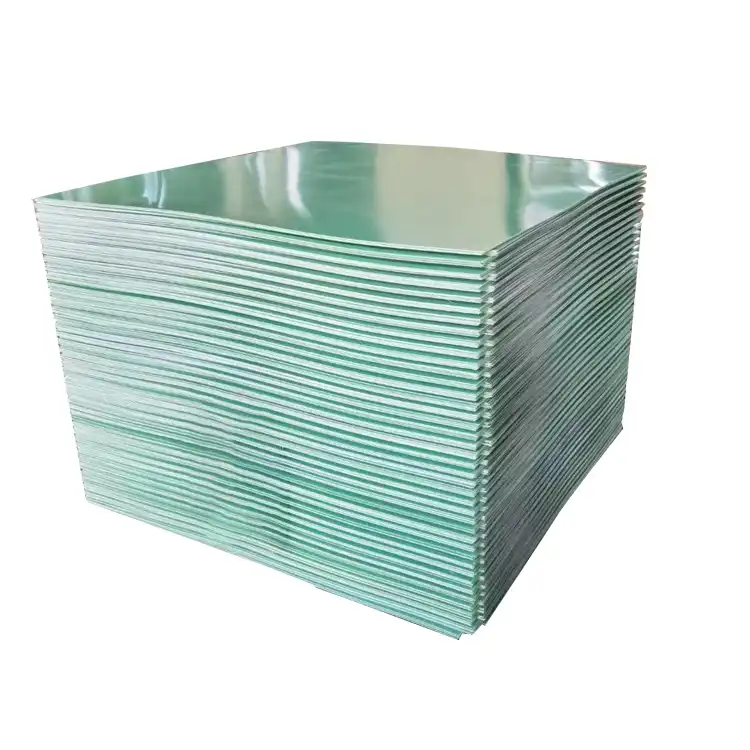Understanding FR4 Sheet Properties and Their Impact on Thickness Selection
Electrical Characteristics of FR4 Sheets
FR4 sheets, composed of woven fiberglass cloth impregnated with epoxy resin, boast exceptional electrical insulation properties. The thickness of an FR4 sheet directly influences its dielectric strength and capacitance. Thicker sheets generally offer higher breakdown voltage resistance, making them suitable for high-voltage applications. Conversely, thinner sheets may be preferable in scenarios where minimal signal loss and improved signal integrity are paramount. It's essential to consider the operating frequency of your application, as the sheet's thickness can affect impedance control and signal propagation.
Mechanical Strength and Durability Considerations
The mechanical robustness of FR4 sheets is intrinsically linked to their thickness. Thicker sheets provide enhanced structural integrity, making them ideal for applications subject to physical stress or vibration. They offer superior resistance to warping, bending, and impact damage. However, this increased strength comes at the cost of added weight and reduced flexibility. Thinner sheets, while more susceptible to mechanical stress, offer greater flexibility and are often preferred in compact designs or applications requiring intricate shaping.
Thermal Management and Heat Dissipation
FR4 sheet thickness plays a significant role in thermal management within electronic assemblies. Thicker sheets generally provide better thermal insulation, which can be advantageous in protecting sensitive components from external heat sources. However, they may also impede heat dissipation from internal components. Thinner sheets, while less effective as thermal insulators, can facilitate more efficient heat transfer. In applications where thermal management is critical, it's crucial to balance the sheet's insulating properties with the need for effective heat dissipation, potentially incorporating additional cooling mechanisms.
Key Factors Influencing FR4 Sheet Thickness Selection
Application-Specific Requirements
The intended use of the FR4 sheet is paramount in determining the optimal thickness. High-frequency applications, such as RF circuits, often benefit from thinner sheets to minimize signal loss and maintain impedance control. Conversely, power electronics or high-voltage systems may require thicker sheets to ensure adequate insulation and breakdown resistance. Consider the specific demands of your application, including operating voltages, frequencies, and environmental conditions, to guide your thickness selection.
Design Constraints and Space Limitations
Physical space constraints within a product or system can significantly influence FR4 sheet thickness choices. In compact or miniaturized designs, thinner sheets may be necessary to meet size requirements while still providing essential electrical and mechanical properties. However, it's crucial to ensure that reducing thickness doesn't compromise the sheet's ability to meet performance specifications. In some cases, innovative design approaches or alternative materials may be required to balance space limitations with functional requirements.
Manufacturing and Processing Considerations
The manufacturability of your design is intricately linked to FR4 sheet thickness. Thicker sheets may pose challenges in certain fabrication processes, such as drilling small-diameter holes or creating fine-pitch traces. They may also require specialized equipment or techniques for cutting and shaping. Conversely, extremely thin sheets can be difficult to handle during assembly and may be more prone to damage. Consider the capabilities of your manufacturing partners and the complexity of your design when selecting sheet thickness to ensure producibility and cost-effectiveness.
Optimizing FR4 Sheet Thickness for Specific Applications
High-Frequency and RF Applications
In high-frequency and RF applications, FR4 sheet thickness plays a crucial role in maintaining signal integrity and minimizing losses. Thinner sheets, typically ranging from 0.2mm to 0.8mm, are often preferred due to their lower dielectric losses and improved impedance control. These thicknesses allow for tighter control of trace geometries and facilitate the creation of microstrip and stripline structures essential for high-frequency signal propagation. However, it's important to balance the electrical performance benefits with mechanical stability requirements, potentially utilizing multilayer designs or selective reinforcement techniques to achieve optimal results.
Power Electronics and High-Voltage Systems
Power electronics and high-voltage applications demand FR4 sheets with superior insulation properties and thermal management capabilities. Thicker sheets, typically ranging from 1.6mm to 3.2mm or more, are commonly employed in these scenarios. The increased thickness provides enhanced dielectric strength, crucial for preventing voltage breakdown and ensuring long-term reliability. Additionally, thicker sheets offer improved thermal dissipation, helping to manage heat generated by power components. When selecting FR4 sheet thickness for these applications, consider factors such as operating voltages, current-carrying requirements, and thermal cycling conditions to ensure adequate performance and safety margins.
Structural and Mechanical Support Applications
FR4 sheets are not limited to electrical applications; they also serve as excellent structural materials in various mechanical designs. For these uses, thickness selection is primarily driven by mechanical strength and rigidity requirements. Thicker sheets, often 2.4mm and above, provide superior load-bearing capacity and resistance to flexing or warping. They are ideal for creating rigid support structures, enclosures, or mounting plates in electronic assemblies. When utilizing FR4 sheets for structural purposes, consider factors such as expected loads, vibration environments, and any need for machining or fastening. In some cases, laminating multiple thinner sheets may offer a balance between strength and weight, providing design flexibility while maintaining structural integrity.
Conclusion
Selecting the appropriate FR4 sheet thickness is a multifaceted decision that requires careful consideration of electrical, mechanical, thermal, and manufacturing factors. By thoroughly analyzing your application's specific requirements and constraints, you can optimize the performance and cost-effectiveness of your design. Remember that the ideal thickness may involve compromises between competing factors, and innovative solutions such as multi-layer designs or hybrid materials may be necessary for particularly challenging applications. Ultimately, the right choice will ensure your product meets its performance goals while maintaining reliability and manufacturability.
Contact Us
For expert guidance on selecting the perfect FR4 sheet thickness for your specific application, or to explore our wide range of high-quality insulating materials, don't hesitate to reach out. Contact our team of specialists at info@jhd-material.com for personalized assistance and to learn how our 20+ years of experience in producing and selling insulating sheets can benefit your project.






